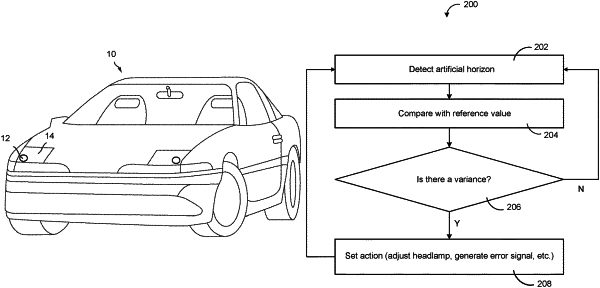| CPC B60Q 1/0023 (2013.01) [B60Q 1/143 (2013.01); G06V 10/141 (2022.01); G06V 20/56 (2022.01); G06V 20/584 (2022.01); H05B 47/11 (2020.01)] | 24 Claims |

|
1. A vehicular vision system, the vehicular vision system comprising:
a camera disposed at a vehicle, the camera having a field of view at least forward of the vehicle, the camera operable to capture frames of image data representative of an area forward of the vehicle;
a directed light source disposed at the vehicle and operable to emit light when activated, wherein the directed light source comprises a headlamp of the vehicle, and wherein light emitted by the directed light source, when activated, illuminates a field of illumination forward of the vehicle;
wherein the field of view of the camera encompasses at least a portion of the field of illumination;
a control comprising an image processor and associated circuitry, wherein frames of image data captured by the camera are provided to the control for processing by the image processor;
wherein the frames of image data provided to the control comprise (i) a first frame of image data captured by the camera with the directed light source set to a selected light setting, and (ii) a second frame of image data captured by the camera subsequent to the first frame of image data and with the directed light source set to the selected light setting;
wherein the control, via image processing by the image processor of at least the first and second frames of image data captured by the camera, determines (i) a first field of illumination of the directed light source present in the first frame of image data and indicative of alignment of the directed light source relative to the vehicle during capture of the first frame of image data, and (ii) a second field of illumination of the directed light source present in the second frame of image data and indicative of alignment of the directed light source relative to the vehicle during capture of the second frame of image data;
wherein the control, responsive to determining the first field of illumination and the second field of illumination, compares the determined first field of illumination and the determined second field of illumination to determine, a change in the field of illumination illuminated by the directed light source between capture of the first frame of image data and capture of the second frame of image data, the change in the field of illumination being indicative of a change in alignment of the directed light source relative to the vehicle when the change in the field of illumination between capture of the first frame of image data and capture of the second frame of image data is greater than a predetermined threshold; and
wherein, responsive to determining a change in the field of illumination that is indicative of a change in alignment of the directed light source relative to the vehicle, the control at least one selected from the group consisting of (i) adjusts the directed light source to accommodate the change in alignment of the directed light source and (ii) generates an alert to an occupant in the vehicle.
|